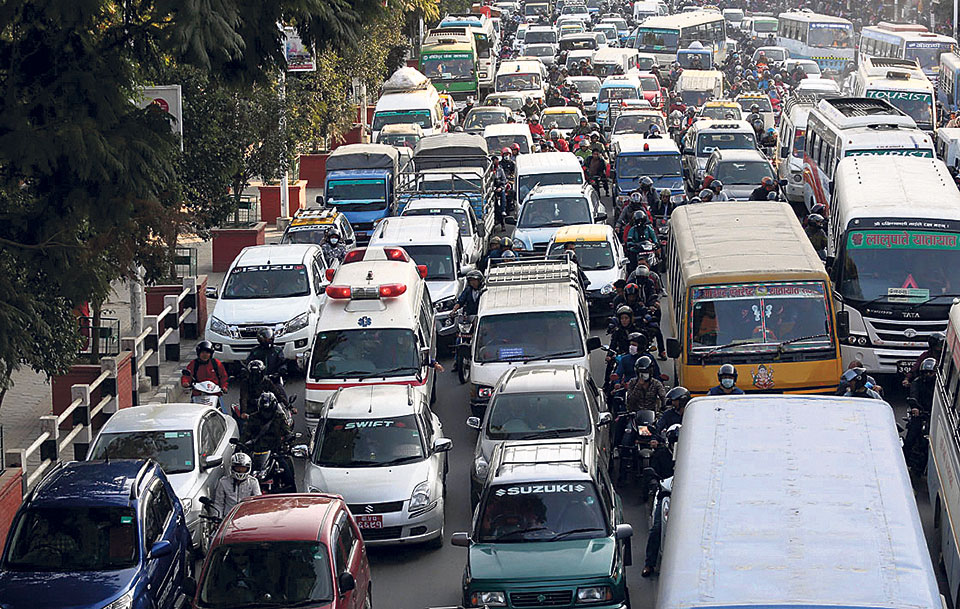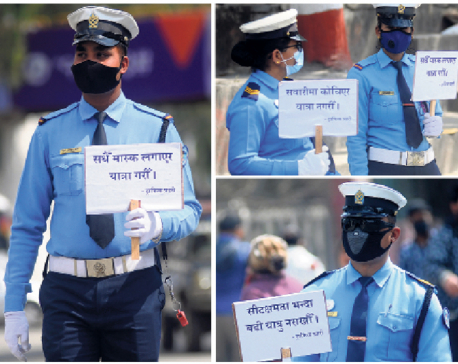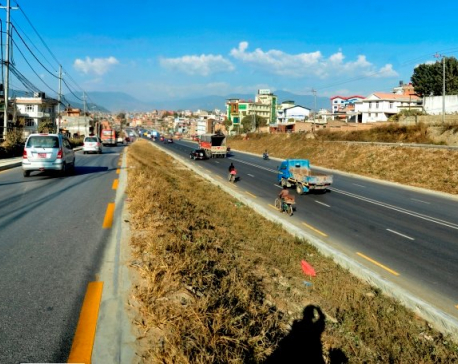
OR
Too many vehicles, too short road
Published On: January 19, 2020 09:14 AM NPT By: Thaneshwor Chalise

Until the dichotomy between the number of vehicles and the size of road is bridged, traffic congestion will haunt us as a nightmare
The traffic lights are out of order. They have been dead since I started walking the route. I always have to cross this section of the road to reach my workstation. It’s a long-stretched singular road with interior subways adjoining it. Making a cross always feels like an uphill battle. The traffic police are occasionally spotted at duty. Last week, a bike almost ran over me. Fortunately, I escaped it before it could plough into my body. Neither of us was at fault. Both of us wanted to proceed further for there was no traffic signal to systematize our turns. But will I always be fortunate enough to survive the road accident? Do we always have to rely on luck or the government should address the situation with gravity?
Traffic jam in Kathmandu Valley has been a notorious setback facing both the vehicles, passengers as well as the traffic police. Vehicles can’t reach destinations on time, passengers can’t get punctual at their workstations and traffic police must wrestle to regulate the movement all the time. So where does the problem lie? It emanates from ‘too many vehicles, too short roads’.
Few narrow roads
Metropolitan cities often fall victim to the traffic hazards of any kind. Primary reason is metro is a hub of enormous opportunities, facilities and employments. People living in the country flock to the urban city to pursue career. The uncontrolled migration into the city inflates the population and consequently demands the high number of vehicles for the regular service of transportation.
Kathmandu offers what other parts of the country do not have: Colleges and universities, well-equipped hospitals, profitable market for business and trade and so forth. So, people are bound to come to this place. The number of vehicles increases. The roads remain the same exacerbating traffic chaos.
A brief study of the statistics provided by the Kathmandu Metropolitan Traffic Police Division appalls anyone. The report reveals that the total road length of the valley is 4.5 million feet. What’s terrifying is that the total number of vehicles, if lined up into a single-file procession, would exceed 7.2 million feet. The Division further mentions that the number of vehicle is exponentially increasing. The road space is too small to contain the mushrooming number of vehicles. The authority informs that there are some stretches that can never be widened while few of the sections are costly. The data is disturbing. Standing on these reports, one can easily predict how rumpus the traffic system looks if registration of vehicles isn’t halted on the selective basis.
Promote big buses
It’s obvious that the inflow of population can’t be restrained. The immediate option is to suspend the registration of small-sized microbuses and encourage the big and cozy public buses like Sajha Yatayat. Empirically speaking, more passengers prefer travelling via large-sized comfortable buses like Sajha Yatayat to small-sized suffocating microbuses. When I set out for my workstation from Kirtipur, I can see a long queue waiting for big busses whereas the microbuses hardly appeal them.
Mani Gautam, my colleague, says: “I have a bike. But I choose to go to my workstation by public transportation.” The absolute reason is large-sized buses offer spacious seats, airy windows and peaceful journey. Gautam’s choice can teach us two lessons: one, if all the bikers start using public vehicles except for emergency, it can considerably reduce the number of bikes easing road space. Two, it can contribute to mitigating the frequent petroleum crisis.
Besides, the dysfunctional status of the traffic lights in most of the sections equally account for the road traffic. Officials from Traffic Division estimate that nearly 90 percent of the existing traffic lights are out of service. The remaining ones are on the verge of being defunct. As a result, the Traffic Division deploys 1,400 traffic police personnel to substitute the dead lights. Even this does not help in infamous sites of prolonged jams such as Tripureshwor, Koteshwor and Thapathali.
Why are not the police fixing those lights? The Traffic Division claims that 40 percept of traffic jam can be lessened only by mending these traffic lights.
We need to look into our conduct as well. If we maximize the use of public transportation instead of using bikes, cars and other private vehicles, it could also contribute to lessening the traffic jam. This is desirable for two reasons: It’s affordable enough, it’s comfortable enough, it’s reliable enough and it’s approachable enough for the traffic police personnel to systematically organize the vehicle movement.
Kathmandu is the most populated city. It results in high number of vehicles. The collusion between populous vehicles and limited road space poses a threat to road safety and traffic management. If we could tighten the registration of vehicles selectively, with the big buses in top priority, and if we could encourage people to use public transportation instead of private vehicles, it could go a long way in addressing the traffic chaos.
But in the long run, until the dichotomy between the number of vehicles and the size of the road is bridged, traffic congestion will continue to haunt us as a prolonged nightmare.
Email: tchalise91@gmail.com
You May Like This

High speed and breach of traffic rules main cause of road accidents
KATHMANDU, Oct 2: The traffic police have concluded that breach of traffic rules and overspeed are the main reasons for... Read More...

As COVID-19 threat increases, traffic police launch awareness drive
KATHMANDU, March 21: Considering the growing global Coronavirus (COVID-19) threat, the Metropolitan Traffic Police Office (MTPO) has initiated a new... Read More...

Metro Police begins to detect over speed of vehicles along Kalanki-Koteshwor road section
KATHMANDU, June 4: Amid the rising trend of road accidents in the Kalanki-Koteshwor stretch of the Ring Road, the Metropolitan... Read More...




Just In
- Nepal faces Hong Kong today for ACC Emerging Teams Asia Cup
- 286 new industries registered in Nepal in first nine months of current FY, attracting Rs 165 billion investment
- UML's National Convention Representatives Council meeting today
- Gandaki Province CM assigns ministerial portfolios to Hari Bahadur Chuman and Deepak Manange
- 352 climbers obtain permits to ascend Mount Everest this season
- 16 candidates shortlisted for CEO position at Nepal Tourism Board
- WB to take financial management lead for proposed Upper Arun Project
- Power supply to be affected in parts of Kathmandu Valley today as NEA expedites repair works







_20220508065243.jpg)








Leave A Comment